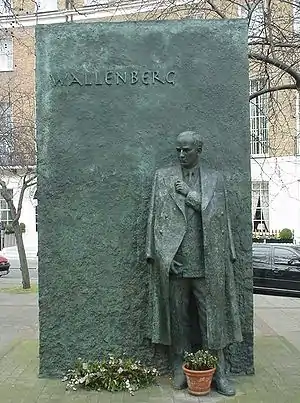Wallenberg family
The Wallenberg family are a prominent Swedish family renowned as bankers, industrialists, politicians, bureaucrats, and diplomats.
| Wallenberg | |
|---|---|
| Banking Industry | |
| Country | |
| Place of origin | Linköping, Lund, Stockholm |
| Founded | 1856 |
| Founder | André Oscar Wallenberg |
| Titles | Knights of the Seraphim Order |
| Members |
|
| Connected families | |
| Traditions | Lutheranism |
| Motto | Esse non videri[1] ("To be, not to be seen") |
| Estate(s) |
|
| Website | www |
According to Financial Times, it is the most powerful dynasty of Europe, if not the world, in terms of controlling the biggest empire by market value and strategic companies.
The Wallenbergs control and are majority owners of most large Swedish industrial groups, such as world leading telecommunication multinational Ericsson, Scandinavian and Baltic bank giant Skandinaviska Enskilda Banken, world's largest paper and pulp multinational Stora Enso, Wärtsilä, Electrolux, ABB, aerospace SAAB, SAS Group, world's largest ball-bearing company SKF, Atlas Copco, pharmaceutical multinational Astra Zeneca, Nasdaq, Inc., Husqvarna, the Stockholm football club AIK, investment company Investor AB, the Grand Group hotel, BraunAbility, Epiroc, Höganäs AB, IPCO, Laborie, EQT, Nefab, Permobil, Piab, Sobi, Sarnova, TreScandinavia, Kopparfors Skogar, Hylte Bruk AB and so on.
In the 1970s, the Wallenberg family businesses employed 40% of Sweden's industrial workforce and represented 40% of the total worth of the Stockholm stock market.[2]
Wallenbergs, through the Knut and Alice Wallenberg Foundation, allocate annually SEK 2 billion to science and research, which makes the Foundation one of the largest private research foundations in Europe.
Take for example the Wallenbergs', Sweden's leading financial family. They started out as bankers, with Stockholm Enskilda Bank, which was founded in 1856 by André Oscar Wallenberg. With the bank as base, they ventured into industry, founding or acquiring a number of the country's leading multinational companies: ASEA, Electrolux, Ericsson, Saab-Scania, SKF, Stora. At the end of the 20th century, these companies accounted for about 40 percent of Swedish export value. The Wallenbergs' do not necessarily have to have large shareholdings in these companies, but thanks to the system of shares with different voting rights, they usually have the majority rights. According to the British magazine the Economist, the Wallenbergs' are unique among Europe's industrial dynasties with their five generations of extremely successful entrepreneurs. According to the family historian David Bartal, this is a family of Japanese measures, Europe's most powerful of its kind, more discreet than Agnellis' and richer than Rothschilds'. The combined sales figured for the companies in the Wallenberg Group at the end of 20th century exceeds ninety billion dollars a year, which is more than British Petroleum, IBM and General Electrics are able to show. But if you look for "Wallenberg Ltd." you will be disappointed. Discretion primarily.
The most famous of the Wallenbergs, Raoul Wallenberg, a diplomat, worked in Budapest, Hungary, during World War II to rescue Jews from the Holocaust. Between July and December 1944, he issued protective passports and housed Jews, saving tens of thousands of Jewish lives.[3]
History


The earliest known member of the Wallenberg family is Per Hansson (1670–1741) who, in 1692, married Kerstin Jacobsdotter Schuut (1671–1752). Their son, Jakob Persson Wallenberg (1699–1758) married twice. The children of his first marriage called themselves Wallenberg and those of his second called themselves Wallenberg.[4] Jakob Persson Wallenberg was the great-grandfather of André Oscar Wallenberg who, in 1856, founded Stockholms Enskilda Bank, the predecessor of today's Skandinaviska Enskilda Banken.[2] A. O. Wallenberg, the founder of the SEB Bank, was son of Bishop of Linköping, Marcus Wallenberg, and his wife Anna Laurentia Barfoth, daughter of professor Anders Barfoth at Lund university and Elsa Maria Bager, of the famous merchant family Bager of Malmö.
André Oscar Wallenberg's son Knut Agathon Wallenberg took over as CEO of Stockholms Enskilda Bank in 1886. Like many other Wallenberg relatives, Knut Agathon Wallenberg was also involved in Swedish politics and diplomacy becoming Minister for Foreign Affairs 1914–1917, and member of the Riksdags first chamber (Parliament of Sweden) 1907–1919. In 1916, new legislation made it more difficult for banks to own shares in industrial companies on a long-term basis. Investor was formed as an investment part of Stockholms Enskilda Bank.
Knut Agathon Wallenberg's younger brother Marcus Wallenberg (senior) carried on the tradition and took over as the bank's CEO in 1911, replacing his older brother who was appointed Stockholms Enskilda Bank chairman of the board.
Gustaf Oscar Wallenberg was during the 1890s CEO of the ferry-line Trelleborg-Sassnitz. Later on he became Sweden's minister to Japan. He became well known for his stern refusal to let his daughter Nita Wallenberg marry the artist Nils von Dardel to whom she became secretly engaged in 1917[5] Dardel was told by her family that he "did not meet the requirements to be married into the Wallenberg family".[6] The risk that Dardel would take advantage of being married into the family was considered very high. Nita Wallenberg was forced to burn all of Dardel's letters and was given a place in the families bank business and told to forget her romance.[7] Wallenbeg was married twice, with Danish man Carl Johan Kierullf, and later to businessman Carl Axel Söderlund during 1930 to 1944, and had three children.[8]
Jacob Wallenberg, eldest son of Marcus Wallenberg (senior), became the bank's CEO after Joseph Nachmanson died in 1927, joined by younger brother Marcus Wallenberg (junior) as the bank's deputy CEO. In 1938, Knut Agathon Wallenberg died. He had no children. Marcus Wallenberg (senior) was appointed Stockholms Enskilda Bank chairman of the board.
During the War the Bank collaborated with the German government. The Secretary of the US Treasury, Henry Morgenthau Jr. considered Jacob Wallenberg strongly pro-German, and the US subjected the Bank to a blockade that was only lifted in 1947.[9][10]
The fourth generation of Wallenbergs joined the family business in 1953, including heir apparent Marc Wallenberg, eldest son of Marcus Wallenberg (junior), who became a deputy CEO at Stockholms Enskilda Bank in 1953, before taking over as CEO in 1958. After a power struggle between Jacob Wallenberg and his younger brother Marcus Wallenberg (junior), Jacob Wallenberg resigned from the board of directors in 1969.
The resignation opened a seat on the bank's board of directors to Peter Wallenberg (senior), younger son of Marcus Wallenberg (junior). Marcus Wallenberg (junior) pushed through a merger agreement between Stockholms Enskilda Bank and rival Skandinaviska Banken in 1971. Soon after, tragedy struck when Marc Wallenberg committed suicide, observers suggested that the act came possibly because Marc Wallenberg felt himself inadequate to the task of leading what was to become the Scandinavia banking giant Skandinaviska Enskilda Banken. The merger went through in 1972.
Marcus Wallenberg (junior), and younger son Peter Wallenberg (senior), focused their interests on the family's investment companies, Investor and Providentia. Investor now became the family's new flagship business, and, under Marcus Wallenberg (juniors) leadership began actively promoting the restructuring of most of the industrial companies under its control, replacing board members and promoting younger CEO and other management.
Peter Wallenberg (senior) took over after Marcus Wallenberg (junior's) death in 1982. For many outsiders, the change in leadership marked a final moment in the family's more than 100-year dominance of the Swedish banking and industrial sectors. Yet Peter Wallenberg (senior) rose to the challenge, guiding Investor and Sweden's industry into a new era. In 1990, it was estimated that the family indirectly controlled one-third of the Swedish Gross National Product.[11] Peter Wallenberg (senior) stepped down from leadership of Investor in 1997.
In 2006, the fifth generation took over the Wallenberg sphere. Marcus Wallenberg, son of Marc Wallenberg, Jacob Wallenberg and Peter Wallenberg (junior) both sons of Peter Wallenberg (senior).
Modern business
The Wallenbergs have a very low-key public profile, eschewing conspicuous displays of wealth. The family motto is Esse, non Videri (Latin for "To be, not to be seen").[12] Marcus Wallenberg Sr. adopted this motto when he became a Knight and Commander of the Royal Order of the Seraphim in 1931.[13]
The Wallenbergs business empire is often referred to as the Wallenberg sphere, the Wallenberg sphere is a large group of companies where their investment company, Investor AB, or foundation asset management company, Foundation Asset Management (FAM), have the controlling interest.
Estates and Building Projects
Some of the estates owned or financed by the Wallenbergs are Malmvik Manor, Brevik Manor, Vidbynäs Manor, Villa Täcka Udden, Investor Arsenalgatan 8c, SEB Banking Palace, Stockholm City Hall, Saltsjöbaden Grand Hotel, Grand Hotel Stockholm, Wallenbergska Villan, Stockholm School of Economics.
Notable family members
| Marcus Wallenberg 1744–1799 | Jacob Wallenberg 1746–1778 | ||||||||||||||||||||||||||||||||||||||||||||||||||
| Marcus Wallenberg 1774–1833 | |||||||||||||||||||||||||||||||||||||||||||||||||||
| Catharina Wilhelmina Andersson | André Oscar Wallenberg 1816–1886 | Anna von Sydow | |||||||||||||||||||||||||||||||||||||||||||||||||
| Knut Agathon Wallenberg 1853–1938 | Gustaf Wallenberg 1863–1937 | Marcus Wallenberg Sr. 1864–1943 | Oscar Wallenberg 1872–1939 | Axel Wallenberg 1874–1963 | Victor Wallenberg 1875–1970 | ||||||||||||||||||||||||||||||||||||||||||||||
| Raoul Oscar Wallenberg 1888–1912 | Jacob Wallenberg 1892–1980 | Marcus Wallenberg Jr. 1899–1982 | Carol Wallenberg 1904–1985 | Gustaf Wally 1905–1966 | Henry Wallenberg 1908–1993 | ||||||||||||||||||||||||||||||||||||||||||||||
| Raoul Wallenberg 1912–c.1947 | Peder Wallenberg 1935– | Marc Wallenberg 1924–1971 | Peter Wallenberg Sr. 1926–2015 | ||||||||||||||||||||||||||||||||||||||||||||||||
| Marcus Wallenberg 1956– | Axel Wallenberg 1958–2011 | Jacob Wallenberg 1956– | Peter Wallenberg Jr. 1959– | ||||||||||||||||||||||||||||||||||||||||||||||||
- Marcus Wallenberg (1744–1799), priest, lector of theology
- Marcus Wallenberg (1774–1833), nephew of Jacob Wallenberg, bishop in Linköping.
- André Oscar Wallenberg (1816–1886), son of Marcus Wallenberg, naval officer, newspaper tycoon, banker and politician.
- Knut Agathon Wallenberg (1853–1938), son of André Oscar Wallenberg, banker and politician.
- Gustaf Wallenberg (1863–1937), son of André Oscar Wallenberg, diplomat.
- Raoul Oscar Wallenberg (1888–1912), son of Gustaf Wallenberg, naval officer.
- Raoul Wallenberg (1912–c.1947), son of Raoul Oscar Wallenberg, diplomat.
- Raoul Oscar Wallenberg (1888–1912), son of Gustaf Wallenberg, naval officer.
- Marcus Wallenberg Sr. ("Häradshövdingen") (1864–1943), son of André Oscar Wallenberg, banker, industrialist and politician.
- Sonja Emilie Wallenberg (1891-1970), daughter of Marcus Wallenberg Sr. and Amalia Wallenberg (née Hagdahl), married to count Carl Johan Magnus Johan Björnstjerna.
- Ulla Anna Charlotta Björnstjerna (1916-)
- Elizabeth Helena Amalia Charlotta Björnstjerna (1917-2010)
- Sonja Monica Charlotta Björnstjerna (1920-1955)
- Sonja Ingeborg Charlotta Björnstjerna
- Jacob Wallenberg ("Juju") (1892–1980), son of Marcus Wallenberg Sr., naval officer, banker, industrialist.
- Peder Wallenberg (1935–), son of Jacob Wallenberg, architect, businessman.
- Fredrik Wallenberg
- Marie Wallenberg
- Peder Wallenberg
- Nicholas Wallenberg
- Anna Wallenberg
- Peder Wallenberg Jr.
- Christopher Wallenberg
- Alexander Wallenberg
- Peder Wallenberg (1935–), son of Jacob Wallenberg, architect, businessman.
- Andrea Wallenberg (1894-1980), daughter of Marcus Wallenberg Sr. and Amalia Wallenberg (née Hagdahl), married to count Hakon Mörner af Morlanda
- Gunilla Bonde Mörner af Morlanda ("Grotte") (1919-1994)
- Caroline Mörner af Morlanda ("Gyllenkrok") (1922-2004)
- Gertrud Wallenberg (1895-1983), daughter of Marcus Wallenberg Sr. and Amalia Wallenber (née Hagdahl), married on graf count Ferdinand Maria Emmerich Eduard Arco auf Valley, and partner of statesman and baron Carl Gustaf Emil Mannerheim
- Ebba Wallenberg (1896-1960), daughter of Marcus Wallenberg Sr. and Amalia Wallenberg (née Hagdahl), married to count Carl Gustaf Bonde af Björnö(1872-1957)
- Peder Carlsson Bonde af Björnö (1923-2013)
- Marcus Wallenberg Jr. ("Dodde") (1899–1982), son of Marcus Wallenberg Sr., banker and industrialist.
- Marc Wallenberg ("Boy-Boy") (1924–1971), son of Marcus Wallenberg Jr., banker.
- Marcus Wallenberg ("Husky") (1956–), son of Marc Wallenberg, banker and industrialist.
- Axel Wallenberg ("Vava") (1958–2011), son of Marc Wallenberg, businessman.
- Peter Wallenberg Sr. ("Pirre") (1926–2015), son of Marcus Wallenberg Jr., banker and industrialist.
- Jacob Wallenberg (1956–), son of Peter Wallenberg Sr., banker and industrialist.
- Lovisa Wallenberg
- Jacob Wallenberg Jr.
- Alice Wallenberg
- Peter Wallenberg Jr. ("Poker") (1959–), son of Peter Wallenberg Sr., businessman and racing driver.
- Jacob Wallenberg (1956–), son of Peter Wallenberg Sr., banker and industrialist.
- Marc Wallenberg ("Boy-Boy") (1924–1971), son of Marcus Wallenberg Jr., banker.
- Sonja Emilie Wallenberg (1891-1970), daughter of Marcus Wallenberg Sr. and Amalia Wallenberg (née Hagdahl), married to count Carl Johan Magnus Johan Björnstjerna.
- Oscar Wallenberg (1872–1939), son of André Oscar Wallenberg, naval officer and businessman.
- Carol Wallenberg (1904–1985), son of Oscar Wallenberg, businessman.
- Axel Wallenberg (1874–1963), son of André Oscar Wallenberg, industrialist and diplomat.
- Gustaf Wally (1905–1966), son of Axel Wallenberg, dancer, actor and theatre manager.
- Victor Wallenberg (1875–1970), son of André Oscar Wallenberg, sports shooter.
- Henry Wallenberg (1908–1993), son of Victor Wallenberg, consul general in Monaco.
- André Oscar Wallenberg (1816–1886), son of Marcus Wallenberg, naval officer, newspaper tycoon, banker and politician.
- Marcus Wallenberg (1774–1833), nephew of Jacob Wallenberg, bishop in Linköping.
- Jacob Wallenberg (1746–1778), sailor, clergyman and author.
Key people
 André Oscar Wallenberg. (1816–1886)
André Oscar Wallenberg. (1816–1886) Knut Agathon Wallenberg. (1853–1938)
Knut Agathon Wallenberg. (1853–1938) Marcus Wallenberg Sr.. (1864–1943) Wearing the star of a Knight of the Seraphim.
Marcus Wallenberg Sr.. (1864–1943) Wearing the star of a Knight of the Seraphim..jpg.webp) Jacob Wallenberg. (1892–1980)
Jacob Wallenberg. (1892–1980) Nita Wallenberg (1896-1966), in a 1917 canvass portrait by Nils von Dardel
Nita Wallenberg (1896-1966), in a 1917 canvass portrait by Nils von Dardel Marcus Wallenberg Jr. (1899–1982)
Marcus Wallenberg Jr. (1899–1982) Raoul Wallenberg. (1912–c.1947)
Raoul Wallenberg. (1912–c.1947) Marc Wallenberg. (1924–1971)
Marc Wallenberg. (1924–1971) Jacob Wallenberg. (1956–)
Jacob Wallenberg. (1956–) Gustaf Wallenberg
Gustaf Wallenberg
References
- Luisa Greco (22 May 2015). "Cosimo de Medici e l'amore per le tartarughe con la vela". Toctoc.
- "A Nordic pyramid". The Economist. Retrieved 10 June 2017.
- "Yad Vashem database". Yad Vashem. Archived from the original on 7 February 2007. Retrieved 12 February 2007.
who saved the lives of tens of thousands of Jews in Budapest during World War II ... and put some 15,000 Jews into 32 safe houses.
- The Swedish family calendar 1989, red. Elisabeth Thorsell, Almqvist & Wiksell Internationell, Stockholm 1989 ISBN 91-22-01318-0 s.360
- Erik Näslund, Dardel, Författarförlaget 1988, page 1223, 167.
- Thora Dardel, Jag for till Paris, Bonniers 1941, page 23
- Erik Näslund, Dardel, Författarförlaget 1988, page 137.
- Erik Näslund, Dardel, Författarförlaget 1988, page 145.
- "Authors Claim Wallenberg Family Assisted Nazis in Banking Deals". Jewish Telegraphic Agency. 8 November 1989. Retrieved 13 August 2016.
- Gowland, Rob (19 June 1996). "Banks' nazi connections exposed". The Guardian (Socialist Party of Australia).
- based on an article in Reed Business Information's International Management
- based on an article in The New York times
- "Family". Wallenberg.com. Retrieved 24 December 2018.
External links
 Media related to Wallenberg family at Wikimedia Commons
Media related to Wallenberg family at Wikimedia Commons- Wallenberg Family Tree on Kindo
- Investor AB and Wallenberg family history